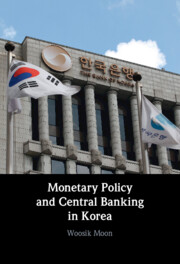Book contents
- Monetary Policy and Central Banking in Korea
- Monetary Policy and Central Banking in Korea
- Copyright page
- Dedication
- Contents
- Figures
- Tables
- Boxes
- Preface and Acknowledgements
- Abbreviations
- Part I What Is the Goal of Korean Monetary Policy?
- Part II How Does Money Affect the Korean Economy?
- Part III How Is Monetary Policy Conducted in Korea?
- 4 The Organisation and Functions of the Bank of Korea
- 5 The Monetary Policy Strategies of the Bank of Korea
- 6 Inflation Targeting in Korea
- 7 The Tools and Instruments of Monetary Policy
- 8 Monetary Policy without Money
- 9 Foreign Exchange Market Intervention and Monetary Policy
- Part IV How Is Financial Stability Pursued in Korea?
- Part V What Will Be the Challenge for Future Monetary Policy in Korea?
- References
- Index
6 - Inflation Targeting in Korea
from Part III - How Is Monetary Policy Conducted in Korea?
Published online by Cambridge University Press: 17 February 2022
- Monetary Policy and Central Banking in Korea
- Monetary Policy and Central Banking in Korea
- Copyright page
- Dedication
- Contents
- Figures
- Tables
- Boxes
- Preface and Acknowledgements
- Abbreviations
- Part I What Is the Goal of Korean Monetary Policy?
- Part II How Does Money Affect the Korean Economy?
- Part III How Is Monetary Policy Conducted in Korea?
- 4 The Organisation and Functions of the Bank of Korea
- 5 The Monetary Policy Strategies of the Bank of Korea
- 6 Inflation Targeting in Korea
- 7 The Tools and Instruments of Monetary Policy
- 8 Monetary Policy without Money
- 9 Foreign Exchange Market Intervention and Monetary Policy
- Part IV How Is Financial Stability Pursued in Korea?
- Part V What Will Be the Challenge for Future Monetary Policy in Korea?
- References
- Index
Summary
Inflation targeting was a very important operational tool in stabilising the inflation rate in many countries when the inflation rate was running high. Korea was no exception to the deployment of this tool. In the past, Korea suffered from relatively high inflation rates and the introduction of inflation targeting contributed to stabilising inflation through the anchoring of the inflation expectations of private agents. The BoK set the target at 3 per cent and focused its operations on reducing inflation to below the target and thus the inflation targeting operations carried out by the BoK were asymmetric. This chapter conducts an assessment of the inflation targeting that Korea has experienced in the aftermath of the 1997 currency crisis.
Keywords
- Type
- Chapter
- Information
- Monetary Policy and Central Banking in Korea , pp. 138 - 161Publisher: Cambridge University PressPrint publication year: 2022

